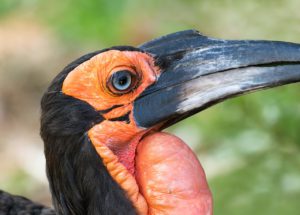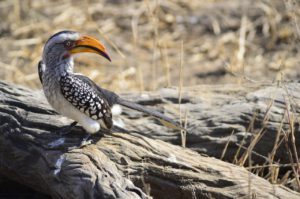What are hornbills?
Hornbills are a group of bird species (about 60 species) from the unique Bucerotidae family. First, all species in the aforementioned family have a specific horn-like growth on their beak (casque). In some species, their casque is made from a hollow, spongy-like material, while in other species their casque is made of a solid ivory-like material. In addition, females have a less pronounced casque compared to their male counterparts. Second, due to the extra weight of the casque, in all hornbills, the first and the second neck vertebrae are fused together. This characteristic is only present in the Bucerotidae (hornbills) family of bird species. Consequently, their neck muscles are much more pronounced and more durable comparing to other bird species.
Why do hornbills have a casque?
Taking into account the discovery of fossilized hornbills from the period of the upper miocene (a period about 11-5 million years ago) i.e. the age of this group of birds, and considering the drastic changes in their body compared to other bird species, one question arises. What is the significance of the casque i.e. why did the casque develop? Since nature is very cruel and does not tolerate any harmful attributes (even unnecessary ones, who do not have a harmful or beneficial effect at all), the very appearance of the mentioned changes in the neck indicates a great importance of the casque for the survival of these bird species. On the one hand, it serves as an echo chamber and therefore makes their voice stronger. As an example, in very dense vegetation (rainforests) visually finding a partner becomes extremely difficult (almost impossible). In such areas, the acoustic localization of a potential partner is of primary importance. In other words, during the mating season, the casque allows them to find potential partners that can be extremely remote and visually undetectable. On the other hand, it also serves as a fitting tool between males and its weight is handicapping males in the struggle for daily survival. Due to their flying properties, most birds can easily escape from predators and other difficulties in nature, which opens the possibility of survival of males with poor genetic quality, i.e. reproducing offspring with a low survival potential. For this reason, natural selection in some species of birds imposes certain traits on males (most often) in order to make their survival more difficult and thus only allow the healthiest and most adaptive to survive, but also to reproduce. Additionally, by fighting between males and hitting their beaks, the casque additionally burdens the neck musculature and skeleton. In other words, during a fight, a healthier and stronger male will win or lose due to a bad diet, disease or a poor genetic predisposition by not withstanding the additional burden on his neck.
Where do hornbills live?
These species can be found in tropical and subtropical parts of Africa, Asia of Malaysia. More precisely, they can be found in sub-Saharan Africa, the Indian sub-continent, to the Philippines and Solomon Islands. A large number of species live arboreal in high vegetation (forests). The exception are two species of the genus Bucorvus. These species live on the ground in open savannah. Most species live in open woodlands or in dense vegetation (rainforests), while a very small number lives in open savannah. Hornbills make their nests in tree or rock cracks. It is interesting that certain species depend on the local elephant population who during feeding, break branches and thus create cracks adequate for the hornbills to nest in.
What do hornbills eat?
This bird family is more or less omnivores. In other words, hornbills feed on fruits, insects and small animals. Interestingly, species present in open areas there are more specialized for carnivorous food, while species that live in the woodlands and dense forests are more specialized for feeding on various fruits. This fact is more than logical, considering that it is easier to find insects and small animals on the open terrain than a fruit tree (e.g. in savannah), while in the forest vegetation the presence of strikingly colored ripe fruits are abundant and easier to consume. Additionally, due to the density of vegetation, it is very difficult to find a prey and land on it from their flying height (there is a high risk of injury during landing). Interestingly, some species can be observed following other animal species (most commonly primates) where they capture the insects that these animals have scare off. Of course, in return, hornbills warn these animals in the presence of a predator or other dangerous situations.
How hornbills reproduce?
The vast majority of species in this group of birds are monogamous. In other words, during the mating season, fully mature individuals find their counterpart and begin to reproduce the offspring, bound together for the rest of their lives. Hornbills that live on the ground have a traditional nesting behavior, while the arboreal species have a somewhat different breeding strategy. Namely, after finding an adequate partner and the discovery of a suitable crack (in a tree on rock), the individuals begin forming a nest where the female enters in the living space and begins with the male carefully to close the cracks. During the closure of the cracks (with mud, leaves and other dry vegetation), in the end, the female is sealed in with only a small opening left. Through this opening, the male feeds his partner, and in couple of weeks, he starts also to feed his newly hatched offspring. The closing of the nest opening serves as a defense against predators, as well as the defense from other individuals who want to occupy their well-deserved nesting place. Later, when the inner space becomes tighter, the female breaks the wall around the cracks and leaves the nest, of course, continuing to feed its offspring from the outside. It is important to note that the parents of some species after leaving the cramped space again close the cracks.
Why are male and female hornbills so different?
In most species of hornbill, males are much larger, have much more pronounced colored feathers, and a much larger horn-like growth on their beak. This difference in morphology between males and females of the same species is called sexual dimorphism. All these differences make the lives of the males more difficult for survival. Through a larger amount of resources that they need (food, water, nesting space), or through greater susceptibility to predators in their surroundings (through coloration and vocalization in search for females during the mating season), or through greater probability of injury during a fight between males, their lives are relatively harsher then of females. Bearing in mind that a male can reproduce a large number of offspring, while one female can reproduce a relatively small number of offspring (due to a limited number of egg cells), it is quite expected that males will to a greater extent take over the burden of survival than females. In this way, nature improves the conditions for selection of the healthiest, strongest and most adapted males, and thus the birth of offspring with the greatest possible potential for survival in nature, but at the same time not reducing the population size of the next generation.
How hornbills intertwine in our cultures?
Taking into account the specificity in the appearance and behavior of these species, it is reasonable to expect that the local human population will eventually incorporate these birds into their culture. For example, the tribe Dayak from Borneo shows hornbills as "the spirit of God" in their artistic contents, tribal dresses and performances. Additionally, every year from 1 to 10 December, local people in Nagaland (Northeast India) celebrate the “Hornbill festival”. This festival is named after the Indian Hornbill who is present in the folklore of most tribes of India. The aim of this aforementioned festival is to get foreigners and the local youth acquainted with local cultural heritage of the Nagaland region and preservation of local cultural communities and their natural heritage.
Are hornbills treated to be extinct?
Depending on species, habitat and extent of human influence, most species are not at risk of disappearance (e.g. Western Piping Hornbill, Black-casqued Hornbill and White-thighed Hornbill). On the other hand, certain species are due to the destruction of their natural habitat, poaching, inadequate activities of people, invasive species and climate change on the verge of survival. Unfortunately, scientists estimate that only about 120 pairs of Visayan wrinkled hornbills are left, and about 20 pairs of Sulu hornbills, which makes their survival extremely difficult and unlikely.
Therefore it is on all of us to promote ethically gathered and farmed products, to support local and world-wide nature conservation projects and to condemn all actions that have a negative impact on biodiversity, not only for our sake but also for the sake our future generations that are to come.
None of the Hornbill products offered in our webshop are from animals caught in the wild. They are all from private collections with documents, or animals that died in a natural way in zoos.
References:
https://en.wikipedia.org/wiki/Hornbill
https://www.iucnredlist.org/species/22725962/94907503
https://www.iucnredlist.org/species/22682621/92954110
https://www.iucnredlist.org/species/22682609/92953893
https://en.wikipedia.org/wiki/Hornbill_Festival
https://www.britannica.com/animal/hornbill
https://theculturetrip.com/asia/malaysia/articles/hornbill-11-facts-about-malaysias-national-bird/
https://animals.sandiegozoo.org/animals/hornbill
https://www.researchgate.net/publication/325091060_Uncontrolled_hunting_and_habitat_degradation_decimate_and_extirpate_forest_hornbills_in_Ghana_West_Africa










